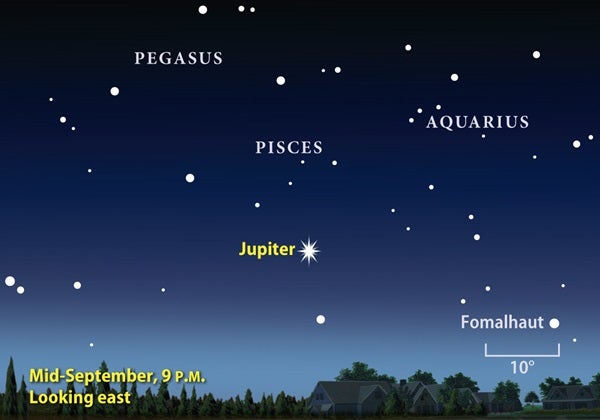Planetary behemoth Jupiter will shine bigger and brighter September 21 than it has in almost 50 years. That’s when it lies at opposition, putting it directly opposite the Sun in Earth’s sky. On the 21st, the jovian giant will rise at sunset, set at sunrise, and remain visible all night.
This opposition is special because Jupiter, the largest of all the solar system’s planets, will soon reach perihelion, the closest point in its orbit to the Sun. That means it’s physically closer to Earth during this opposition than a normal one. It will rise below the Circlet asterism in the constellation Pisces the Fish and present its best views high in the sky, when its light travels through less of Earth’s atmosphere.
“It’ll be a wonderful show this year,” said Michael E. Bakich, Astronomy senior editor. “Jupiter is a great target for beginning observers and old pros alike, and it won’t get better than this. You’ll easily spot its orbiting moons and its northern cloud belt.”
The unexpected disappearance of Jupiter’s South Equatorial Belt (SEB) earlier this year also makes this opposition unusual. The SEB has vanished from sight before, and its return is often impressive, with dramatic storms erupting suddenly. It may be days or years before Jupiter again looks “normal,” just one more reason observers should target the king of planets.
At its nearest, Jupiter will sparkle at magnitude -2.9, and its equator will span 49.9″, making it hard to ignore. “Fans of Jupiter won’t want to miss it,” Bakich said.
- Jupiter is the largest planet in the solar system. More than 1,000 Earths could fit inside Jupiter, and all the other planets together make up only about 70 percent of Jupiter’s volume.
- It takes Jupiter about 12 years to orbit the Sun once, but only about 10 hours to rotate completely, making it the fastest-spinning of all the solar system’s planets.
- Jupiter rotates so rapidly that its polar diameter, 83,082 miles (133,708 kilometers), is only 93 percent of its equatorial diameter, 88,846 miles (142,984 km).
- Jupiter reflects 52 percent of the sunlight falling on it, more than any other planet except Venus (65 percent).
- Jupiter’s four bright moons, Io, Europa, Ganymede, and Callisto, are easily visible through small telescopes. Io takes less than 2 days to orbit, so its relative position visibly changes in an hour or so — less when it appears close to Jupiter.
- Our line of sight lies in the plane of the jovian moons’ orbits, so we see occultations (when a moon moves behind Jupiter), eclipses (when Jupiter’s shadow falls on a moon), and transits (when a moon passes in front of Jupiter) at various times.
- Jupiter’s moon Ganymede is the solar system’s largest satellite, with a diameter of nearly 3,300 miles (5,300 km), greater than that of Mercury.
- Video:Learn more about Jupiter’s fall opposition in “Easy-to-find objects in the 2010 autumn sky.”
- StarDome: Locate Jupiter in your night sky with our interactive star chart.
- Sign up for our free weekly e-mail newsletter.











